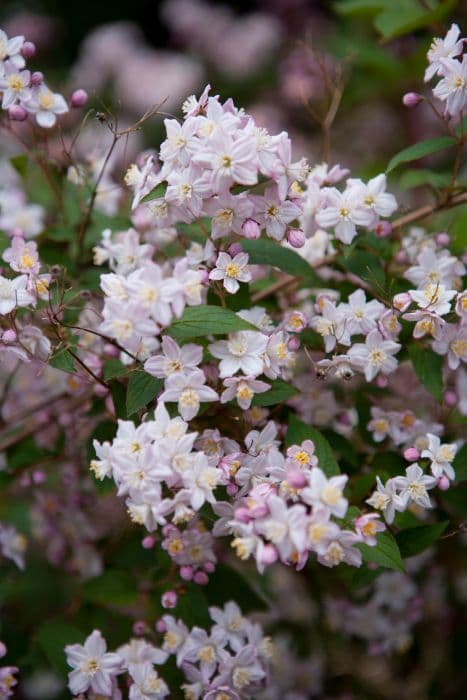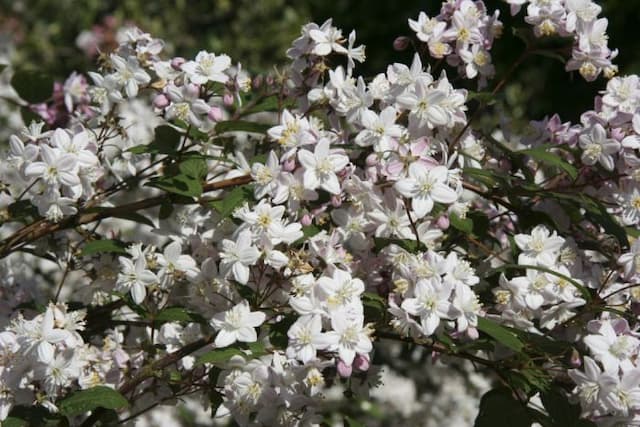Yellow Wax Bells Kirengeshoma palmata

ABOUT
Kirengeshoma palmata, commonly known as yellow wax bells, is a herbaceous perennial with a distinctive and attractive appearance. This plant showcases broad, maple-like leaves that are deeply lobed and have a coarse, palpable texture. The foliage, which emerges in spring, provides a lush, green backdrop for the plant's unique flowers. The flowers of yellow wax bells bloom in late summer to fall, resembling small, nodding bells coated in a waxy substance, from which the plant derives its common name. These blossoms are typically a soft, pale yellow and hang from arching stems, creating a gentle cascading effect. The flowers form in clusters at the ends of the branches, adding a touch of elegance to the plant's overall display. While this description avoids size specifications, the graceful appearance of yellow wax bells, complemented by its heart-shaped leaves and delicate flowers, makes it a charming addition to a shade garden or woodland setting, where its subtle beauty can be appreciated up close. The plant exhibits a lush and full shape, with its features combining to create a serene and slightly exotic presence in the landscape.
About this plant
 Names
NamesFamily
Hydrangeaceae
Synonyms
Yellow Wax Bells, Japanese Wax Bells
Common names
Saruma henryi, Kirengeshoma koreana.
 Toxicity
ToxicityTo humans
Yellow wax bells reportedly do not contain toxic substances that would pose a threat to humans if ingested. Consequently, there is no well-documented toxicity or symptoms of poisoning associated with the consumption of any part of this plant by humans.
To pets
Yellow wax bells are not known to be toxic to pets either. They are generally considered safe, and as such, there are no reports of toxicity or specific symptoms of poisoning in pets consuming parts of this plant. However, it's always prudent to prevent pets from eating plants as individual animals might have unique sensitivities or reactions.
 Characteristics
CharacteristicsLife cycle
Perennials
Foliage type
Deciduous
Color of leaves
Green
Flower color
Yellow
Height
3-4 feet (0.9-1.2 meters)
Spread
2-3 feet (0.6-0.9 meters)
Plant type
Shrub
Hardiness zones
5
Native area
Japan
Benefits
 General Benefits
General Benefits- Ornamental Value: Kirengeshoma palmata, commonly known as Yellow Wax Bells, adds aesthetic value to gardens with its unique yellow bell-shaped flowers and attractive foliage.
- Shade Tolerant: It is well-suited for shaded areas of the garden where other plants might not thrive as well.
- Seasonal Interest: Yellow Wax Bells bloom in late summer to early fall, providing interest in the garden at a time when many other plants have finished flowering.
- Drought Resistance: Once established, this plant can tolerate periods of drought, making it suitable for gardens with less consistent watering.
- Deer Resistance: Kirengeshoma palmata is known to be deer resistant, which is beneficial for gardens in areas with deer pressure.
- Low Maintenance: Requires minimal pruning and care once established, making it a good choice for gardeners looking for low-effort plants.
- Attracts Pollinators: The flowers of the Yellow Wax Bells attract bees and other pollinators, contributing to the health of the garden ecosystem.
 Medical Properties
Medical PropertiesThis plant is not used for medical purposes.
 Air-purifying Qualities
Air-purifying QualitiesThis plant is not specifically known for air purifying qualities.
 Other Uses
Other Uses- Kirengeshoma palmata can be used as a natural dye for fabrics, offering a range of yellow to greenish hues depending on mordants used.
- The leaves of the yellow wax bells can be pressed and used in botanical art for creating detailed prints and patterns.
- It's possible to use the sturdy stems of Kirengeshoma palmata as natural supports for other, lighter-stemmed plants in the garden.
- The seed pods of yellow wax bells can add an interesting visual element to dried flower arrangements or crafts.
- Garden enthusiasts might use this plant to create a 'moon garden' because of its pale flowers that can reflect moonlight at night.
- A gardener might cultivate Kirengeshoma palmata to create a habitat for beneficial insects like bees and butterflies, which are attracted to its flowers.
- The plant's unique shape and shade tolerance make it suitable for themed landscape designs, such as woodland or fairy gardens.
- Photographers and painters may utilize the aesthetic appeal of yellow wax bells as a subject for their artwork, especially due to its distinctive blooms.
- Botany educators might use Kirengeshoma palmata as a live specimen to teach students about characteristics of the Hydrangeaceae family.
- Yellow wax bells can be planted to provide a natural backdrop to outdoor sitting areas, where its flowers enhance the ambience during blooming seasons.
Interesting Facts
 Feng Shui
Feng ShuiThe Yellow wax bells is not used in Feng Shui practice.
 Plant Symbolism
Plant Symbolism- Unique Beauty: Yellow Wax Bells are not as commonly known as many other garden plants, which gives them a unique and exotic appeal. Their distinctive appearance symbolizes the beauty of being unique and standing out from the crowd.
- Rarity: Due to its rarity in gardens and native regions, Yellow Wax Bells symbolize something precious and to be treasured, reminding us to value and protect rare and unique entities.
- Elegance: With their elegant drooping flowers and palmate leaves, Yellow Wax Bells convey a sense of gracefulness and poise, suitable for symbolizing refined beauty.
- End of Summer: As they typically bloom in late summer to early autumn, Yellow Wax Bells can symbolize the transition from summer to fall and the passage of time.
- Peaceful Retreat: Since Yellow Wax Bells are often found in woodland gardens or shaded areas, they symbolize tranquility and the idea of a peaceful, serene escape into nature.
 Water
WaterYellow wax bells prefer consistently moist soil, so it is important to water the plant regularly. Water the plant thoroughly, allowing the water to soak deeply into the soil, which encourages deeper root growth. During the growing season in spring and summer, watering may be required once or twice a week, depending on the weather conditions. Generally, you should aim to provide about 1-1.5 gallons of water each week. In the fall and winter, reduce the frequency of watering as the plant's growth slows down.
 Light
LightYellow wax bells thrive in conditions with dappled or partial shade. The best spot for the plant is where it can receive filtered sunlight, avoiding the intense direct sun of midday, as this can cause leaf scorch. An ideal location would be beneath a canopy of deciduous trees or on the north or east side of a structure where it gets morning sun and afternoon shade.
 Temperature
TemperatureThe ideal temperature range for the Yellow wax bells is between 60°F to 75°F. It can survive minimum temperatures down to around 30°F, but frost can be damaging, so protection or shelter is advisable in colder climates. Ensure the plant is not exposed to temperatures above 85°F for extended periods, as excessive heat may stress the plant.
 Pruning
PruningPruning Yellow wax bells is primarily done to remove spent flowers and dead or damaged foliage, which encourages new growth and maintains a tidy appearance. The best time to prune is in late winter or early spring before new growth starts. Pruning is not typically needed often, just once a year or as required to shape the plant or remove dead material.
 Cleaning
CleaningAs needed
 Soil
SoilYellow wax bells require a well-draining soil mix rich in organic matter, with a pH range of 5.5 to 6.5. A blend of peat, leaf mold, and perlite or sand is ideal.
 Repotting
RepottingYellow wax bells should be repotted every 2 to 3 years to refresh the soil and accommodate root growth.
 Humidity & Misting
Humidity & MistingYellow wax bells prefer high humidity levels, ideally around 60% or more, for optimal growth.
 Suitable locations
Suitable locationsIndoor
Place Yellow wax bells in bright, indirect light and maintain high humidity.
Outdoor
Plant Yellow wax bells in part shade and sheltered from strong winds.
Hardiness zone
5-8 USDA
 Life cycle
Life cycleKirengeshoma palmata, commonly known as yellow wax bells, begins its life as a seed, which upon germination in moist, humus-rich soil, develops into a seedling with rudimentary leaves. As the seedling matures, it forms a clump of heart-shaped, coarsely toothed foliage, characteristic of its perennial nature. The plant then enters a vegetative stage where it grows larger and stronger, preparing for the flowering stage. In late summer to early fall, Kirengeshoma palmata produces pendulous, bell-shaped yellow flowers on arching stems, which attract pollinators. After pollination, the flowers develop into dry, capsule-like fruits that release seeds, ensuring the propagation of the species for the next season. Throughout the winter, the plant dies back to the ground, with the underground rhizomes surviving to regrow the following spring.
 Propogation
PropogationPropogation time
Late winter to early spring
The most popular method of propagation for Kirengeshoma palmata, commonly known as yellow wax bells, is division. This process is ideally done in the spring before the plant commences its rapid growth or in the fall after the plant has flowered and the foliage has died back. To propagate by division, carefully dig up the plant ensuring you have a large root ball. Using a sharp spade or knife, divide the root clump into smaller sections, each with several shoots and a portion of the root system. Replant the divisions immediately, spacing them about 12 to 24 inches (approximately 30 to 60 centimeters) apart to allow for growth, and water thoroughly. This method of propagation allows gardeners to quickly increase their stock of yellow wax bells while ensuring the new plants are true to the parent's form.







![Hydrangea [Early Sensation]](/_next/image?url=https%3A%2F%2Fplants-admin.emdemapps.com%2Fimages%2Fplants%2F%2Fimages%2F604b6150338db.png&w=640&q=75)

